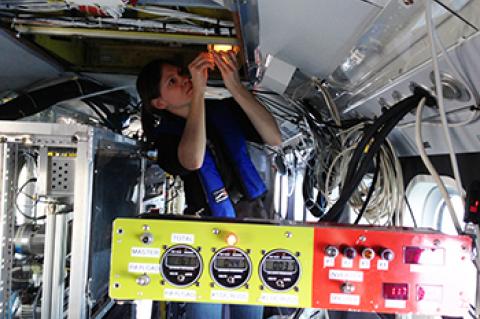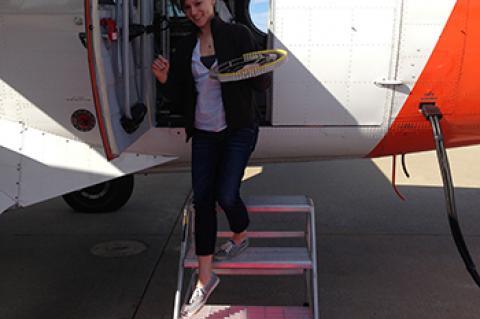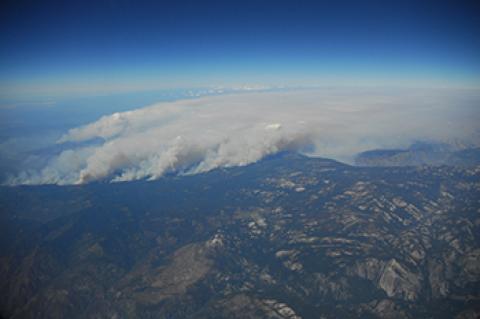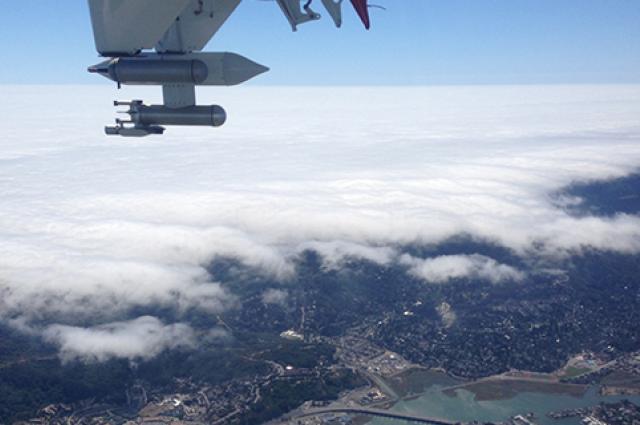ChEE Professor Opens up the Skies for Graduate Students
Related Story: Researchers Pinning Down Aerosols to Shed Light on Climate Change

It is no wonder Armin Sorooshian, UA assistant professor of chemical and environmental engineering, has been invited back to participate in the highly competitive National Academy of Engineering’s Frontiers of Engineering symposiums for three years running -- the first two years to present research on how clouds and aerosols interact in the atmosphere and again in late October 2013 to share knowledge as an educator. He is researching a highly debated topic: climate change. And his colleagues and students, particularly graduate students who spent summer-fall 2013 in the air as part of two different field studies, hold him in high esteem.
“We are very privileged,” said Lindsay Maudlin, a second-year atmospheric science doctoral candidate working with Sorooshian.
From Storm Chasing to Cloud (Water) Catching
Maudlin’s summer started with safety training and wrapped with a red carpet -- laid out by project mechanics -- as she disembarked, cloud water samples in hand, from a Navy Twin Otter in Monterey. She was one of three graduate students on Sorooshian’s team who collaborated with scientists from the Naval Post Graduate School and Caltech on the NiCE, or Nucleation in California Experiment, project.


Over six weeks in July and August 2013, the NiCE research team flew 23 flights, 130 flight hours, up to 5,000 feet in altitude aboard the small, unpressurized plane.
“Humans can only go up to about 7,000 feet in an unpressurized cabin before it would get interesting for some people,” said Maudlin.
The team was studying how aerosol particles interact with clouds in Earth’s atmosphere.
“The largest area of uncertainty lies in aerosols and how aerosols interact with clouds and how they directly impact the radiation balance,” said Maudlin, referring to the Summary for Policymakers released by the Intergovernmental Panel on Climate Change in September 2013. Maudlin was the only UA student to take to the air on the plane packed with equipment, two pilots and two scientists.
“Once we know a little more about aerosols, their properties and how they interact with clouds, that knowledge can be applied to climate models to help predict long-range climate changes,” she said.
When she wasn’t helping UA graduate students Zhen Wang and Gouri Prabhakar sample air and take measurements on the ground, mine data from the flights, and maintain instruments, Maudlin was learning on the job. She guided pilots to layers of dirty air with specific characteristics, monitored instruments aboard the plane, and collected cloud water from a tube jutting out the top of the plane.
“Dr. Sorooshian takes the students into the field and stresses the ‘why’ of education and research,” said Maudlin, who actually started out chasing storms for an undergraduate degree in meteorology at the University of Oklahoma.
Mentoring his students was the best part of the summer for Sorooshian.
“Wow! Just to see the looks on their faces; they were so excited and so engaged,” said Sorooshian, who earned his bachelor’s in chemical and environmental engineering at the UA in 2003 and his PhD in chemical engineering from the California Institute of Technology in 2008.
Life Aboard NASA’s Biggest Flying Lab
In contrast to Maudlin’s missions out of Monterey aboard a small plane without even a bathroom, Taylor Shingler spent summer 2013 aboard a NASA commercial-sized DC-8, with eight crew members and up to 35 scientists from throughout the United States.
Based near the Johnson Space Center in Houston in August-September 2013, Shingler flew 23 flights, about 175 flight hours, at altitudes between 1,000 and 40,000 feet over rural areas of every state except a few in the Northeast.
“You see a ton of the country that way,” said Shingler, a chemical engineering doctoral candidate about halfway through his graduate work. “But it gets very, very bumpy in a nice big plane down there sampling stuff coming straight off the surface of the earth.”
Shingler and fellow UA graduate student Ewan Crosbie were participating with Sorooshian in a NASA field campaign called SEAC4RS, or Studies of Emissions and Atmospheric Composition, Clouds and Climate Coupling by Regional Surveys. The study, which took five years to plan and included a fleet of three planes, looked at North American monsoons, forest fires and agricultural fires, biogenic emissions from plants, and hurricanes.
The UA researchers were conducting measurements with an instrument developed by Sorooshian that measures water uptake properties of aerosols to see how particles grow when they are exposed to water vapor. Since Shingler goes wherever Sorooshian’s DASH SP, or differential aerosol sizing and hygroscopicity spectrometer probe, goes, he was on nearly every low-flying mission.
Results from the tests are important to understanding climate change; the hydrologic, or water, cycle; air quality; and effects of particulate matter on human health.
“From here we can deduce scattering properties of aerosols with different sizes and chemical properties,” said Shingler, adding, “As soon as we get through some of the data processing, we can tease out some results and come to some conclusions.”


